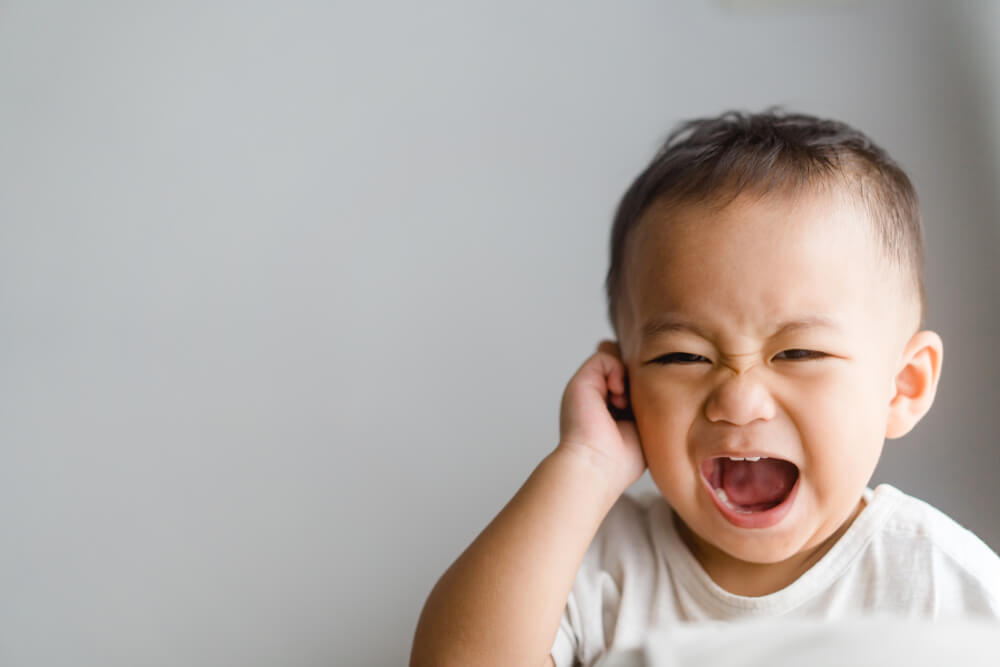An ear infection occurs when there is inflammation of your child’s middle ear. While anyone can get an ear infection, they tend to be more common in children than adults. There is also a link between the throat and ear pain in babies more than in adults.
Five out of six children under the age of three will get a baby ear infection at some point. More parents who bring their children to see pediatricians do so because of baby ear infection. Scientifically, an ear infection is known as otitis media (OM). In this article, we look at signs of baby ear infections.
What Causes an Ear Infection?
The ear has main sections. These are the outer ear, middle ear, and inner ear. The outer ear is what’s seen as the ear on the outside. It also comprises the ear canal, which starts at the ear’s opening and connects the outer ear to the eardrum. The eardrum is a membranous structure that divides the outer ear from the middle ear. A baby ear infection occurs in the middle ear.
Bacteria is the main cause of most ear infections. These conditions usually begin after a child has had a sore throat, cold, or other upper respiratory condition. If bacteria caused the upper respiratory infection, the same bacteria might find their way to the middle ear. This is why there is a link between the throat and ear pain.
Sometimes a respiratory infection can be caused by a virus initially. Later on, bacteria will be drawn to the microbe-friendly environment, where it will cause a secondary bacterial infection. The bacteria will then migrate to the middle ear and cause otitis media. The collection of fluid at the back of the eardrum will respond to the secondary bacterial infection.

Why Are Ear Infections Common in Children?
There are a few reasons why children are more prone to ear infections than adults. Read on to find out why:
- The eustachian tubes in children are a lot smaller and more level in kids. This makes it difficult for fluid to leave the ear even in the absence of a baby ear infection. When the eustachian tubes are blocked with mucus or inflamed, fluid will remain stuck behind the eardrum. This is why you will see fluid discharge as one of the common signs of baby ear infections.
- The immune system in children is not as developed and aware as that of adults. That’s because the immune system develops over time and becomes more aware of potential risks with age and exposure to various bacteria and viruses. This makes it a lot more difficult for children to fight infections that cause throat and ear pain.
What Are the Types of Ear Infections?
There are three common kinds of ear infections. Each of these three shows different signs of baby ear infections and symptoms.
Acute Otitis Media
This is the most prevalent ear infection in children. It occurs when parts of the middle ear become infected by bacteria. The result of this infection is inflammation and pain. You will also notice that there will be some fluid in baby ears. However, this can only be detected by qualified professionals. This condition is quite painful for kids, with most of them experiencing throat and ear pain . They will also show an elevated temperature.
Otitis Media With Effusion
This condition usually occurs after an initial ear infection has passed. Instead of the infection being resolved completely, some fluid will remain trapped behind the eardrum. Children with otitis media with effusion might not even display any signs of ear infection symptoms. However, if your child has received treatment for an initial painful infection, the doctor might pick up OME during a review session. They will tell that there is still some fluid in baby ears using a special instrument.
Chronic Otitis Media With Effusion
This disease occurs when fluid stays trapped in the middle ear for long periods. Sometimes it can be recurring, whereby the fluid in baby ears will keep coming back over and over again. This condition doesn’t always mean there is an actual bacterial infection. Sometimes it occurs even after the initial infection has cleared. Chronic otitis media with effusion makes it difficult for children to fight a new infection. Additionally, it can also end up affecting the child’s hearing ability.
Signs of Baby Ear Infections
A lot of ear infections in children take place before the children can even walk. Therefore, it also means that they might not communicate with you verbally and tell you that their ear hurts. If that’s the case, there you can watch out for the following ear infection symptoms baby:
- The child keeps tugging or pulling at their ear(s)
- Since there will be inflammation and fluid trapped in the child’s ear, they will experience some level of discomfort. This causes them to keep pulling at their ear in an attempt to relieve the irritation.
- Crying a lot or being fussy all the time
- Children, especially infants, respond to discomfort by crying. That is one of the most common ear infection symptoms a baby will display. Ear infection can be quite painful, and a child will cry more than usual if they are suffering from one.
- Difficulties in sleeping
- For children to sleep easily, they need to be comfortable. Because of the pain they experience with an ear infection, they might start staying awake for longer hours.
- A high fever, typically in infants and toddlers
- Fever is one of the immune system’s responses to infection. Adults usually get a fever when they catch a viral infection. However, in children, otitis media can also cause a fever.

Discharge of Fluid in Baby Ears
This is one of the hallmarks of ear infections. Inflammation and swelling cause the collection of fluid in baby ears. This fluid will be trapped behind the child’s eardrum. Therefore, if you notice any fluid coming out of your baby’s ear, it most certainly will be an ear infection.
Issues with Balance or Clumsy Movement
Some organs are responsible for balance within the baby’s ear. These organs might be affected by the inflammation and fluid gathering in the ear; therefore, balance can be affected.
Difficulty in Hearing or Failure to Respond to Quiet Sounds
The problem in the hearing will most likely be due to the inflammation and fluid which causes a blockage of the ear canal. As a result, the baby won’t be able to perceive softer sounds.
How long will it take my baby to get better?
After taking your baby to the doctor, they will usually start feeling a lot better after a few days. If they don’t recover for more than a week after you visit the doctor, it’s advisable to call the doctor and make another appointment. Either they will need to prescribe a different antibiotic or find out if there is anything else affecting them. Please note that fluid might remain in the baby’s ear even weeks after the infection has cleared.
Ear infections are pretty common in children. However, they are not too challenging to treat once you take your child to the doctor.
Have you come across a child with an ear infection before? If you have, please feel free to leave a comment below and tell us what you think about the information in this article.
Also, if your child is suffering from an ear infection and you need additional information, don’t hesitate to reach out to us. Feel free to subscribe to our mailing list to get notifications about new articles that we post.




